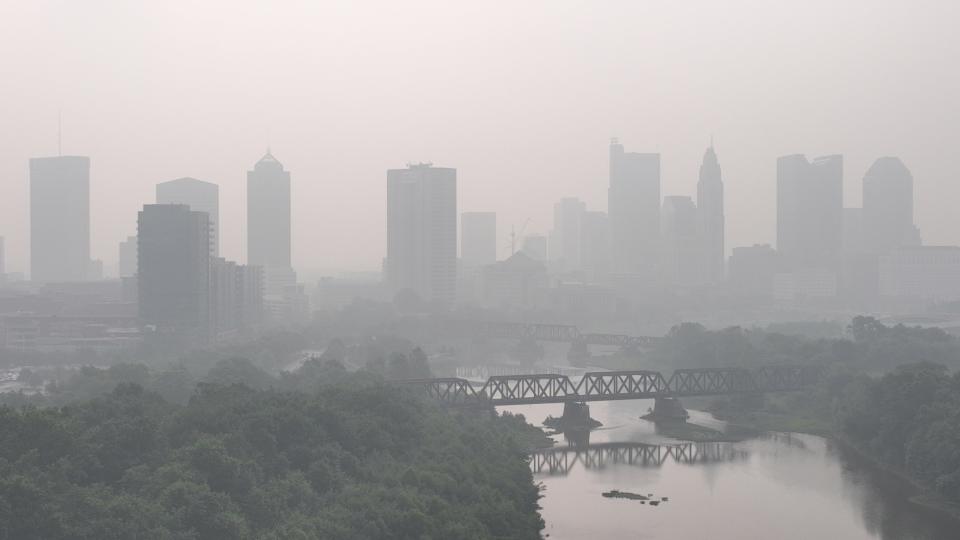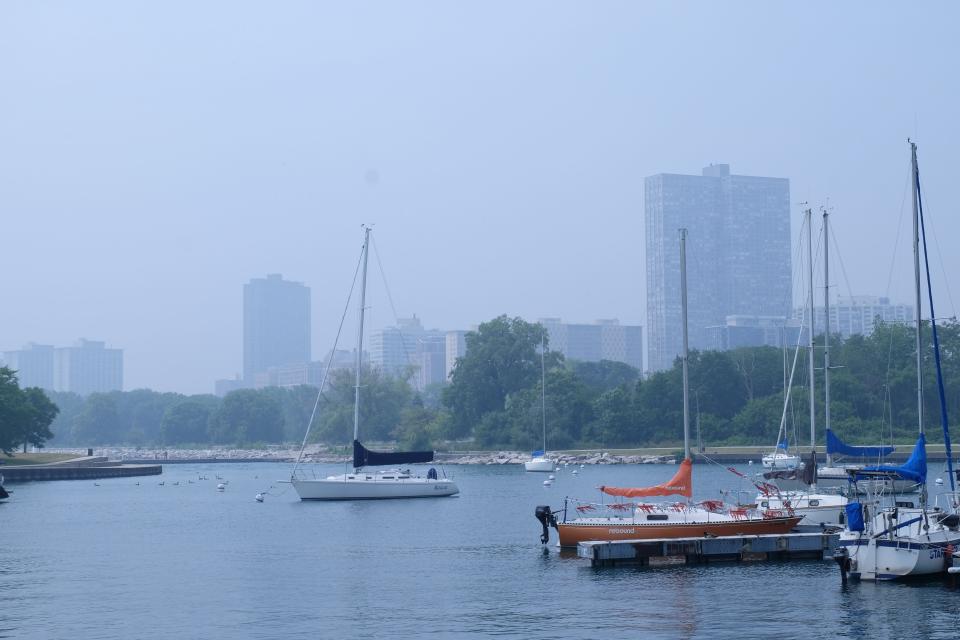Canadian wildfire smoke moves across map, spreading bad air quality to Midwest, East Coast
Smoke drifting into the U.S. from wildfires burning in Canada was continuing to make air quality unhealthy in much of the Midwest, and East Coast residents were bracing for another wave of haze.
About 102 million people live in areas were expected to reach at least a code orange level of air quality Wednesday, which is unhealthy for sensitive groups, the Environmental Protection Agency said.
Chicagoans awoke to a clouded, gray sky, limiting visibility, irritating lungs and filling noses with a thick burning smell for the second straight day Wednesday. The sky was smoky in Milwaukee, Indianapolis and several other metropolises. In Detroit, smoke combined with a dense fog to limit visibility to below a quarter-mile early Wednesday, forcing drivers to take extra caution.
Populations on the East Coast also were under air quality alerts Wednesday, including the Washington, D.C., area. The quality was expected to worsen and spread up and down the coast, infiltrating the New York City region and as far south as the Carolinas into Thursday.
Particulate levels set record highs Tuesday for the past two decades in Buffalo, New York; Cincinnati; Grand Rapids, Michigan; Madison, Wisconsin; and Milwaukee, the Weather Channel reported.
“You can smell it bad,” said Priti Marwah, who was beginning a run along Chicago's lakefront. "I run a hundred miles a week, so this is going to be dangerous today. You can feel it. ... Just even parking right there and coming out, I can feel it in my lungs.”

Here's what you need to know about the air quality Wednesday:
Which US city has the worst air quality?
Three U.S. cities ranked among the top five major cities in the world with the worst air quality Wednesday morning: Detroit, Chicago and Minneapolis, according to IQ Air's live ranking of major world cities. Washington, D.C., made the top 10.
According to AirNow.gov, huge swaths of the Midwest had air quality in at least the red, or "unhealthy" level, including most or all of the states of Iowa, Wisconsin, Illinois, Indiana, Ohio, Michigan and Pennsylvania. Parts of Minnesota, Missouri, Kentucky, West Virginia, Virginia and New York were also in the red on a national map.
The air was "very unhealthy" − purple on the air quality index map − in parts of Wisconsin, Iowa, Illinois, Indiana, Ohio, Pennsylvania and Michigan.
"It’s kind of miserable some days because you can’t spend a lot of time outside," said Dan Daley in St. Louis Park, Minnesota.
We’re already seeing unhealthy air quality in Western New York, Central New York and the Eastern Lake Ontario regions.
If you’re heading out for the day, especially if you’re in a vulnerable group, check the latest air quality information and take steps to protect yourself. pic.twitter.com/FZO5Qc6xWW— Governor Kathy Hochul (@GovKathyHochul) June 28, 2023
New Yorkers were expecting more unhealthy air coming back their way over the next couple of days, weeks after the state reached hazardous levels and residents were blanketed in an orange haze.
"There’s a potential for temporary spikes in Air Quality Index levels to reach 'Very Unhealthy' or 'Hazardous,'" the New York State Department of Health said Wednesday.
Other parts of the East Coast, including the Washington, D.C., region and stretching as far south as the Carolinas, should expect air quality in at least the "unhealthy for sensitive groups" range beginning Wednesday and into Thursday, according to a national air quality forecast from AirNow.gov.

Where is the smoke coming from?
Air quality is unhealthy because of the level of particulates in the air from Canadian wildfires, which have drifted into the U.S. at various points in the past several weeks.
There were 483 active wildfires throughout Canada as of Tuesday, according to the Canadian Interagency Forest Fire Centre. Of those, 253 were considered out of control. Nearly a quarter of the fires burning in Canada were in Quebec.
This year has seen a record-breaking fire season for Canada, and it's still early. More than 29,393 square miles have burned this year, exceeding the record set in 1989 of 29,187 square miles, according to the National Forestry Database.
SEE IT ON A MAP: Detroit, Chicago among Midwest cities impacted by Canadian wildfire smoke
What to do if air quality is bad
Depending on the level of the air quality, people should take levels of precaution depending on whether they have underlying conditions or are in sensitive age groups. Older people, children and people with heart and lung problems should take greater care to avoid strenuous activity outdoors or stay inside as much as they can. When the air quality reaches an unhealthy level for everyone, it's best for all to stay indoors.
The small particles in wildfire smoke can irritate the eyes, nose and throat and can affect the heart and lungs, making it harder to breathe.
Keep windows and doors shut to prevent smoky air from getting inside, and use air purifiers to improve indoor air quality. If you must go outside, make it brief and wear an N95 or better mask, experts say.
New York Gov. Kathy Hochul said masks will be made available free throughout the state. The Metropolitan Transportation Authority said it was handing out KN95 masks at transit stations Wednesday.
HOW TO PROTECT YOUR PETS: Bad air quality from Canada wildfire smoke harms your pets, too. How to keep them safe.
Wisconsin shatters record for worst air quality since at least 1999
The air quality index in parts of Wisconsin hit a high not seen since the index was introduced to measure air pollution in 1999 on Tuesday.
Prior to Tuesday, the Wisconsin record for a daily AQI average was 165. On Tuesday, Milwaukee's average was 225.
"The state of Wisconsin is experiencing a historic air quality event and is currently observing some of the highest concentrations of particulate air pollution on record," the Department of Natural Resources' Craig Czarnecki said. "This is the worst air quality we’ve seen since 1999."
− Beck Andrew Salgado, Milwaukee Journal Sentinel
US air quality map
How the air quality index works. What is the worst air quality?
As people seek ways to stay safe, it is important to understand how the air quality index, or AQI, works. The color-coded system measures the air quality in relation to certain pollutants and the associated health risks at various levels.
The AQI is measured on a scale of 0 to 500. The higher the AQI values, the greater the level of air pollution and health concern there is, according to AirNow.gov. "Levels of concern" in relation to air pollutants range from "good" to "hazardous." This is based on how someone would be affected after breathing in polluted air for a few hours or days.
Each level is also assigned a corresponding color, from green, representing "good," to maroon, representing "hazardous."
If the AQI values are at or are below 100, air quality is generally considered satisfactory. But once the AQI goes above that value, it is unhealthy. Those levels affect certain sensitive groups first but will affect everyone as the AQI values increase. Read more here.
− Olivia Munson, USA TODAY
Contributing: Grace Hauck, USA TODAY; The Associated Press
This article originally appeared on USA TODAY: US air quality map shows cities plagued by Canadian wildfire smoke

